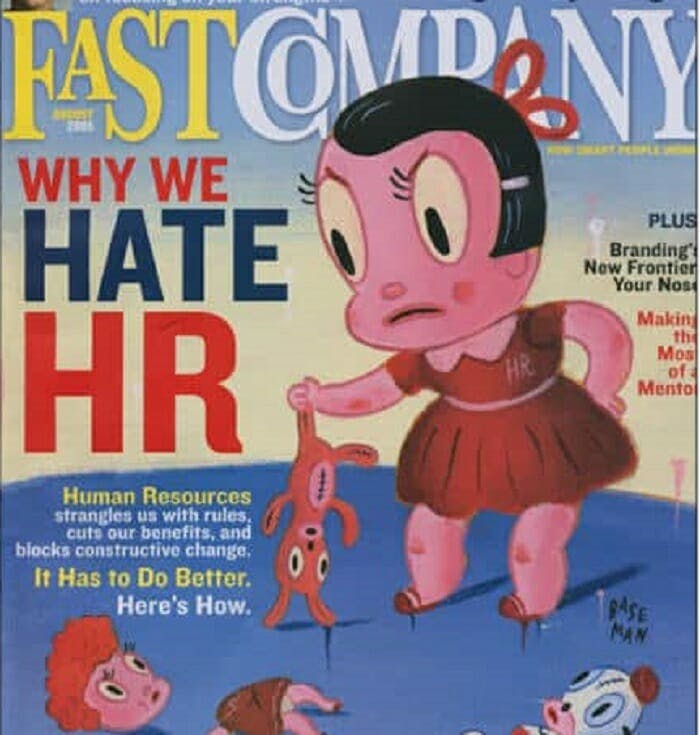The 2005 Fast Company cover story “Why We Hate HR,” by Keith Hammonds, was published 14 years ago today. That article was a shot heard round the world, a litany against a “stuck” profession — one that needs to evolve to a strategic role, but just doesn’t have the intellectual heft to get there.
Calling HR people “neither strategic nor leaders,” Hammonds argued that HR is mostly focused on actions instead of outcomes, and can’t speak the CEO’s language.
His complaints, apparently, were long overdue. The article was amplified in the press, and has even become the subject of scholarly discussion.
Whether today’s new cost- and time-saving HR technology has lessened any of this animosity is still a somewhat open question. It depends on whether HR is taking full advantage of the technology and using it correctly.
Here are 5 questions HR leaders can ask themselves to determine whether they are on the right track or if their C-suite is still sour on them. And some advice on how to turn that CEO hate into high-fives.
1. The employee data you offer your leadership might be sophisticated, but is it strategic?
You might think it’s great to crow to a CEO that the gym memberships your firm offers don’t cost much, and employees love that perk the most. But to be strategic, you’d have to show evidence the gym memberships are actually improving productivity, efficiency or some other meaningful metric. Your CEO wants those answers – do you have them?
2. Are you thinking about AI intelligently?
Artificial intelligence programs sound great to onboard, train and boost retention. And tempting; you just start them up and let them run themselves, right? Nope. You have to keep a watchful eye on AI and monitor whether the programs do what you need them to do and are worth the cost. For example, if you need to see a 5% improvement in retention rate for your AI onboarding program, but don’t meet that number, it’s not worth it — and you and your CEO should know that. Likewise, if it works beautifully and you can tell your leader how much money you’ve saved, you and your CEO can trade high-fives.
3. What kind of data are you putting into your data analytics?
This is a vital question, as HR has to bow to so many different gods — and the data programs (designed by committees of gods) suffer as a result. Take performance data (please, many would say.) It is notoriously packed around the mid-range with few employees rated as outstanding (else salary increases and bonuses would break the budget) and few being rated unsatisfactory (for risk of exposing a lack of training or sparking a parade of disenfranchised workers marching out the door). This is all the more troubling as performance data (good data) is invaluable. Big data and AI programs may do cool things, but if the data that goes into them is unreliable, untidy, and inconsistent, the results can be worthless – the kind of result a CEO detests.
4. Can you translate your employee data into your CEO’s language?
Leadership historically hasn’t really trusted HR to be consultative, informed and capable of speaking the leader’s language. An HR leader needs to be able to connect the dots of its data in a way that resonate with a CEO. Your survey might show your leaders don’t trust their customer-support employees. Those employees might also report frustration. A good HR person would take a good look at customer satisfaction and see if there’s a connection that translates to lost value, and give customer support more power to solve problems – and improve customer retention. This is the kind of insight that will make CEOs listen to and trust you.
5. Are you managing a crisis, or solving the underlying problem?
This is where HR is vital, especially in our age of increased diversity, #MeToo, and the ever-watchful eyes of social media. In the wake of the Les Moonves scandal, CBS is now assigning HR reps to be present on the sets of all of its shows. While that shows faith in HR crisis management, it may only solve part of a problem. HR should be knocking on the CEO’s door to say that they aren’t just a tool to reduce litigation or stop bad behavior. That the real goal is to use data and collaboration to create a cultural shift, so that all employees feel like they are being treated fairly. Not only that, HR would be armed with quality data to explain how this cultural shift would pay for itself and begin to grow revenue in five years, because creating a fair, transparent culture means greater productivity and collaboration. That’s the kind of strategic thinking, and empathy, that could make a CEO’s hate just melt.
